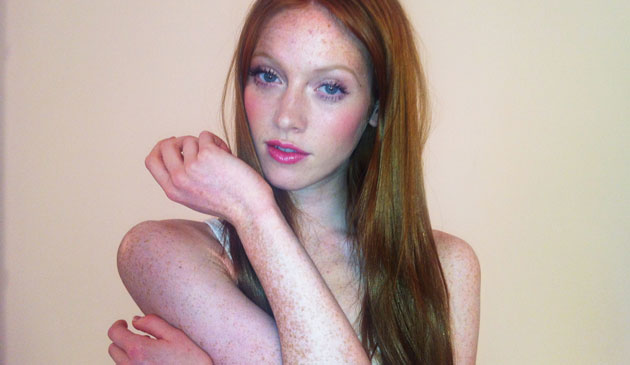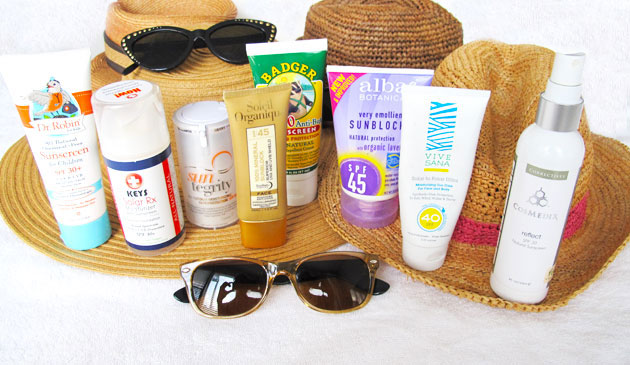...I'll test it for you
It’s not only redheads with freckles who need to be concerned about sun damage. The problem is, the sunscreen aisle is confusing!
June 24, 2012

If you’ve been conflicted about which tube of sunscreen to buy when standing in the drug store, staring at the wall of them, you’re in good company. It’s not only this freckly redheaded beauty named Chantal I worked with recently who needs to concern herself with sun protection – we all do. Not only are there countless options when it comes to the mainstream brands like Coppertone, Neutrogena, and Hawaiian Islands, but the non-toxic market for sun protection, which you may have guessed is what I favor, is seeing a surge in better-for-you-and-the-environment sunblocks to keep sun related skin damage at bay. Good news! Some of the mainstream brands are now offering better options with far fewer scary chemicals. You can see how the ones in your home rate on the Environmental Working Group’s database, here.
There are still a number of factors that you may want to weigh before grabbing the first bottle off the shelves of our local Whole Foods, the ‘green products’ section at Target, or at our favorite health food store.
- What level SPF should I use for every day?
According to the current recommendations, 30 is sufficient. Anything that claims to have protection over 50 is supposedly not any more effective than 50 SPF. - Will it make me break out?
Unfortunately, there’s no way to know until you try. Oil-free and non-communagenic (supposedly formulated not to clog pores) are targeted at those of us prone to breakouts, but my strong belief in the benefits of using a face oil for those with oily, breakout-prone skin, goes against this. I’ve used all of the ones in the photo below and none seem to have triggered a breakout in my very temperamental skin. That doesn’t mean, sadly, that it won’t for you, and that it won’t for me in the future. One sunscreen not pictured below that reliably doesn’t break people out is from EltaMD, and is oil free. - If I have a darker complexion do I still need to wear sunscreen?
Yes, if you want to prevent long-term damage like wrinkles, liver spots, and skin cancers. The more melanin you have in your skin, the more natural sun protection you have, therefore, the likelihood of women with dark to very dark skin experiencing any of these is less than those with lighter skin, but the possibility still remains. - What about the ‘questionable ingredients’ in some all-natural sunscreen?
This question made it difficult for me to tackle writing this post. I had to look at the continuum of ingredients – from those that have been proven to be highly toxic yet still remain in many mainstream sunblocks, to those that some of the more natural lines use that get highly conflicting responses from the scientific experts, with regard to their potential for skin irritation. As I’ve said before, I don’t believe in all or nothing philosophies, which translates in the sunscreen debate to me saying this: despite containing an ingredient or two that may be questioned by some, those that contain, for example, ingredients that give creamy products their slippery feel, making them easier to rub in, like dimethicone, and paraben alternative preservatives like phenoxyenthanol, both of which have been shown in some studies to cause mild skin irritation, the natural brands I’ve listed below are FAR less dangerous to us and our environments than the mainstream ones. - What’s the deal with chemical and barrier sunscreens?
The difference between chemical sunscreens and barrier sunscreens is this: mainstream lines (Coppertone, Neutrogena, Hawaiian Islands, AND most of the traditional makeup brands that sell sunscreen) block the sun by coating your skin with a hefty dose of toxic chemicals. These chemicals may block the sun, but articles like this one from the Environmental Working Group(the leader in honest reporting on cosmetic product ingredients) show that they may also lead to neuro-toxicity, hormone disruption, and even deadlier forms of cancer than what we would be exposed to from direct sun. Ironically, it’s been found that most of the US-approved UV filters, ie. chemical sunscreen ingredient, including: octylmethoxycinnamate, oxybenzone, avobenzone, octocrylene, padimate O, PABA, menthol anthranilate, and Mexoryl SX may release free-radicals into the skin – exactly what they’re trying to prevent the sun from doing.Barrier sunscreens protect the skin by coating it with sunshine ray reflecting particles. Oils like coconut and jojoba have a natural SPF of 4, and carrot seed oil, wheatgerm oil, and crushed red raspberry seed oil, have SPF ratings of 20 and higher, yet they absorb into the skin, making them less than ideal for long-lasting protection. The way natural sunscreens do their job is through the use of small particles of titanium dioxide- a mineral that’s the whitest substance on earth (often used to make white paint its whitest) – which forms a barrier, preventing rays from touching the skin.
- Nano vs non-nano protection?
As advancements in nano-particle technology (nano = making things smaller, think: iPod nano) have advanced, researchers and laboratory scientists began creating teeny tiny titanium dioxide particles for sunscreens so that they wouldn’t leave the users’ skin coated with that tell-tale white haze. Numerous studies over the years had proven no threat from titanium dioxide to the human body when applied to its’ barrier – the skin, so it was thought that we had nothing to worry about. What was overlooked, however, is that the skin isn’t impermeable, and what sits on it is at least 60% absorbed into the blood stream – more so, if it’s micro-sized. Titanium dioxide particles were making their way into organs causing genetic and possibly cellular damage, i.e. cancer, and into our environment through excreted material, causing all sorts of potential weird problems. - How easy is it to rub in? * Will it leave a white residue on my skin even after I’ve rubbed it in?
The products below offer a range of options. As they’re all small containers with price points higher than you may be used to, below I’m offering my thoughts on their use for the face, ears, neck/decollate, and backs of hands.
- The light spray from Cosmedix is very easily rubbed in, and won’t leave you shiny or moisturized at all (you can use your moisturizer beforehand) and has little to no scent. Ideal for under makeup.
- Keys Solar RX is a moisturizer with sunscreen that rubs in very easily, leaves no residue, and is moisturizing enough for most to use in place of an oil or moisturizer, and has a very mild, non-offensive scent. Ideal under makeup.
- SunTegrity is moisturizing but not greasy, rubs in very easily, leaves no white residue nor shine, has a very light and pleasant scent, and offers a few other products, including essentially, a BB cream. Ideal under makeup.
- Vive Sane is highly moisturizing, will leave you with a moisturized glow (read: not ideal for the men in your life), has a very light and pleasant scent, takes a little time to rub in, but once it’s fully in, doesn’t leave a white residue. Great under makeup if you like a highly moisturized look (which I do!)
- Soleil Organique: The highest SPF (45) I’m including. The container is very small, but very effective. It rubs in quite easily, leaves no white residue, and has a moderate scent that smells more chemically than others, but the ingredients are very clean, and offer more skin treatment components than the rest.
- Dr. Robin for Children: Can be used by adults, too, of course. Rubs in easily, has a very light chemical scent, despite absence of any worrisome ingredients. It’s the only one that rubs in easily that is water resistant.
- Alba Botanical Very emollient sunblockand Badger anti-bug sunscreen: Both are more difficult to rub in, leaving behind white residue. Despite this, I like their scents – lavender and citrus, respectively, and they’re both highly water resistant. Alba doesn’t get a great rating this year from the Environmental Working Group, however, so I’m less likely to reach for this one. Given that they’re both very thick, they are good for extended periods of time in the sun, and great for skin that tends to burn more readily: ears, nose, cheek bones, shoulders,and backs of neck.There are lots of others on the market I haven’t yet tried, but am excited to. Next on my list are Coola, 100% Pure, Burt’s Bees, Neil’s Yard, and John Masters Organics. Check out this great blog where the writer posts photos of how the natural sunscreens look on skin and how they wear on her kids at the pool here.
I read one skincare expert say that if you’re not wearing sunscreen every day, you might as well not spend money on anti-aging creams and serums. I rarely believe in all or nothing philosophies, and I urge you, through trial and error, to figure out what’s right for your skin, and your lifestyle, and your bank account. Just like organic produce, some of the best newer natural sunscreens are very expensive. Additionally, I believe that some vitamin D3 directly from the sun onto my skin makes me feel great and is necessary (along with the vitamin D3 supplements I take and LOVE), but I burn pretty easily in direct sunlight, and in recent years my once adorable freckles have started to merge together and old age spots have reminded me that I’m not in my 20’s any more.
I believe in hats, sunglasses (it’s so important to protect the delicate skin around your eyes AND your eyes themselves – sun damage can lead to cataracts!) and walking on the shady side of the street, closing the shade on your car’s sunroof, and wearing a shirt to keep the sun from beating down on your shoulders, ears, neck, and décolletage (collar bone to breast skin). Don’t forget to protect the delicate skin on your lips, too! Luckily there are numerous lip balm products with SPF. You can enjoy the outdoors and the benefits of the sun if you plan a little in advance. Try storing summer hats and sunglasses along with sunscreen by the front door so you never forget them as you leave the house each day.
Enjoy the warmth, everyone! I’m heading out now to do just that.




